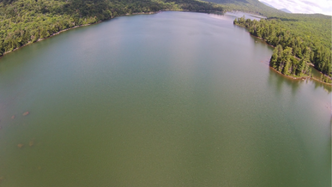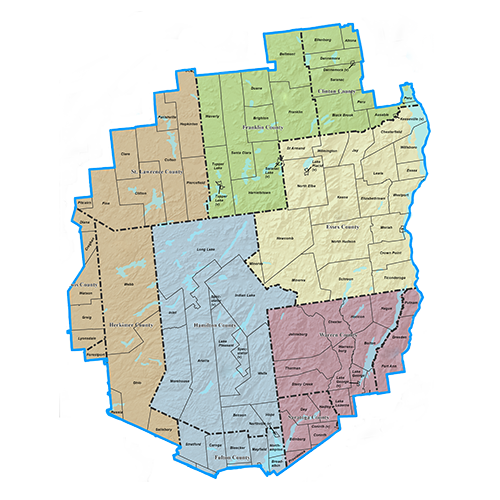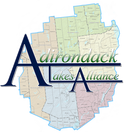By: Margaret Murphy, ALA Regional Director (B) Essex County

A SUNY College of Environmental Science and Forestry undergraduate received the Hudson River Foundation’s Polgar Fellowship this summer to conduct water sampling in Wolf Lake on SUNY-ESF’s Huntington Wildlife Forest (HWF) under my guidance.
Sampling will be conducted to determine if water quality changes observed over the past few summers in Wolf Lake might be due to a relatively unknown but widespread organism, the freshwater jellyfish Craspedacusta sowerbii.
During a fall 2016 fisheries practicum field trip, Wolf Lake’s zooplankton community was qualitatively assessed because the lake had turned green in 2015 and 2016 with no known cause and we were curious why we weren’t catching many fish.
Much to everyone’s surprise, numerous freshwater jellyfish were observed in the collection sampled from about 10 meters below the surface to the surface. They were blooming like crazy in the lake. We quickly figured out what they were, imported from China in the late 1880s, and that they are now fairly widespread throughout New York and the United States.
Wolf Lake has a reputation as a “heritage lake,” (indicating it is among the most pristine water bodies in the Adirondack Park and all of New York State) with an undisturbed watershed and no non-native fishes. Needless to say, this finding has caused Wolf Lake to lose its reputation as a pristine lake. We also wonder if this critter is the reason why the lake has been very green for the last two years and why the fish numbers are way down there too. We hope the research this summer will help us start answering these questions.
Freshwater jellyfish have two primary stages, the polyp stage when they reside on the bottom reproducing asexually, giving rise to more polyps or to the sexually reproducing hydromedusa stage, when conditions are favorable (usually water temperatures at least 25 o C). The hydromedusa is produced only sporadically and actively feed on zooplankton within the water column.
Information in the scientific literature indicates the impact of freshwater jellyfish on lake trophic structure may or may not be harmful, with more recent studies noting an impact with higher chlorophyll and lower numbers of crustacean zooplankton in waters containing freshwater jellyfish hydromedusa. With the noticeable change to green in Wolf Lake over the past two years, we have inferred that there may be an effect on the zooplankton, allowing the phytoplankton to increase in abundance.
With the climate warming, the Adirondacks risk the potential loss of coldwater fish species. Huntington Wildlife Forest has long been an important research facility for assessing regional and global changes, and more rigorous study of the lakes will help us better understand these potential changes throughout the Adirondacks and develop target areas most in need of management and protection.
This summer, we will assess water quality parameters and both phytoplankton and zooplankton community composition in Rich Lake, Wolf Lake, and Arbutus Lake to begin to understand the potential correlation between water quality and plankton dynamics.
Zooplankton sampling will also help determine if freshwater jellyfish hydromedusae are still present in Wolf Lake and if they occur in the other two lakes. Changes in the plankton community have implications for the fish community, and may be a major factor in the reduced catch rate of fish from these lakes in 2016.
Fish sampling will be conducted in both early June and early July to continue to gain understanding of community dynamics and why changes may be occurring. Our results will be used to make recommendations on future monitoring programs to continue to assess changes in these lakes due to climate change and potential impacts from non-native or invasive species and how they may affect the entire watershed and will have implications for waterbodies throughout the Adirondacks.
Original article can be accessed from: Adirondack Almanac
Sampling will be conducted to determine if water quality changes observed over the past few summers in Wolf Lake might be due to a relatively unknown but widespread organism, the freshwater jellyfish Craspedacusta sowerbii.
During a fall 2016 fisheries practicum field trip, Wolf Lake’s zooplankton community was qualitatively assessed because the lake had turned green in 2015 and 2016 with no known cause and we were curious why we weren’t catching many fish.
Much to everyone’s surprise, numerous freshwater jellyfish were observed in the collection sampled from about 10 meters below the surface to the surface. They were blooming like crazy in the lake. We quickly figured out what they were, imported from China in the late 1880s, and that they are now fairly widespread throughout New York and the United States.
Wolf Lake has a reputation as a “heritage lake,” (indicating it is among the most pristine water bodies in the Adirondack Park and all of New York State) with an undisturbed watershed and no non-native fishes. Needless to say, this finding has caused Wolf Lake to lose its reputation as a pristine lake. We also wonder if this critter is the reason why the lake has been very green for the last two years and why the fish numbers are way down there too. We hope the research this summer will help us start answering these questions.
Freshwater jellyfish have two primary stages, the polyp stage when they reside on the bottom reproducing asexually, giving rise to more polyps or to the sexually reproducing hydromedusa stage, when conditions are favorable (usually water temperatures at least 25 o C). The hydromedusa is produced only sporadically and actively feed on zooplankton within the water column.
Information in the scientific literature indicates the impact of freshwater jellyfish on lake trophic structure may or may not be harmful, with more recent studies noting an impact with higher chlorophyll and lower numbers of crustacean zooplankton in waters containing freshwater jellyfish hydromedusa. With the noticeable change to green in Wolf Lake over the past two years, we have inferred that there may be an effect on the zooplankton, allowing the phytoplankton to increase in abundance.
With the climate warming, the Adirondacks risk the potential loss of coldwater fish species. Huntington Wildlife Forest has long been an important research facility for assessing regional and global changes, and more rigorous study of the lakes will help us better understand these potential changes throughout the Adirondacks and develop target areas most in need of management and protection.
This summer, we will assess water quality parameters and both phytoplankton and zooplankton community composition in Rich Lake, Wolf Lake, and Arbutus Lake to begin to understand the potential correlation between water quality and plankton dynamics.
Zooplankton sampling will also help determine if freshwater jellyfish hydromedusae are still present in Wolf Lake and if they occur in the other two lakes. Changes in the plankton community have implications for the fish community, and may be a major factor in the reduced catch rate of fish from these lakes in 2016.
Fish sampling will be conducted in both early June and early July to continue to gain understanding of community dynamics and why changes may be occurring. Our results will be used to make recommendations on future monitoring programs to continue to assess changes in these lakes due to climate change and potential impacts from non-native or invasive species and how they may affect the entire watershed and will have implications for waterbodies throughout the Adirondacks.
Original article can be accessed from: Adirondack Almanac


 RSS Feed
RSS Feed
